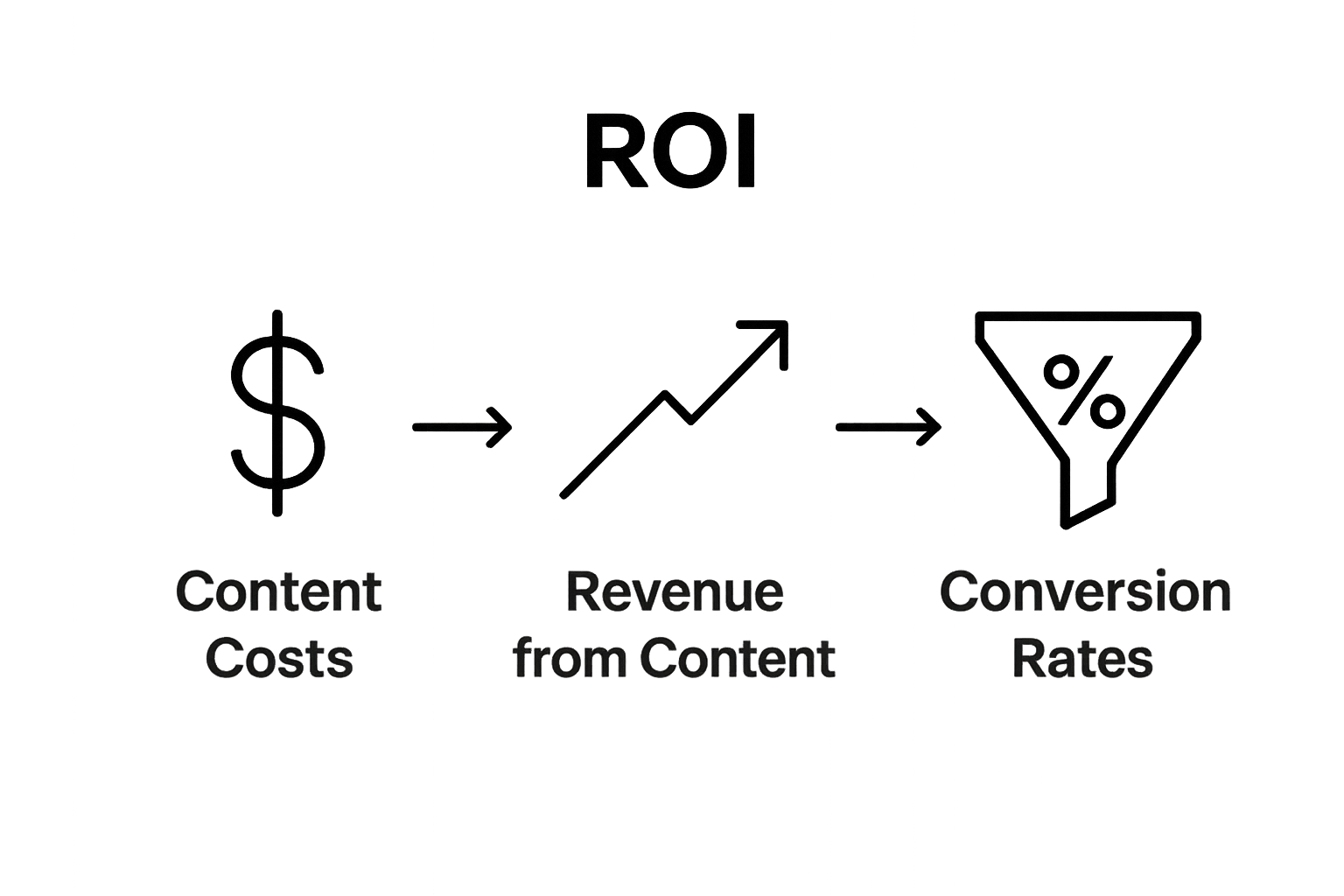Understanding Measuring Content Marketing ROI for Brands
Content marketing is driving real results for brands everywhere. Companies that track their content ROI can outperform competitors by as much as 13 percent in revenue growth. Sounds straightforward, right? Here is where it gets interesting. Most brands focus on production costs and overlook the hidden returns that come from smarter measurement and long term impact. That shift changes everything.
Table of Contents
- What Is Content Marketing ROI And Why It Matters
- Key Metrics For Assessing Content Marketing Success
- The Relationship Between Content Investment And Returns
- Analyzing Data To Measure Content Marketing Effectiveness
- Real-World Examples Of Content Marketing ROI In Action
Quick Summary
| Takeaway | Explanation |
|---|---|
| Measuring ROI is essential for brands | Understanding content marketing ROI helps brands assess their strategies and allocate resources efficiently. |
| Track both quantitative and qualitative metrics | Combining numerical data with qualitative insights reveals deeper impacts on brand value and performance. |
| Invest in content as a long-term strategy | View content marketing expenses as a strategic commitment that contributes to sustained growth and cumulative returns. |
| Focus on continuous optimization | Regularly refining content strategies based on performance data enhances overall marketing effectiveness and ROI. |
| Utilize data analysis for insights | Transforming raw data into strategic insights allows brands to connect content performance to tangible business outcomes. |
What is Content Marketing ROI and Why It Matters
Content marketing ROI represents the measurable financial return brands generate from their strategic content investments. At its core, ROI quantifies how effectively a company’s content marketing efforts translate into tangible business outcomes like revenue, customer acquisition, and brand visibility.
Defining Content Marketing ROI
In practical terms, content marketing ROI calculates the profit or loss generated by content initiatives compared to the total expenses incurred in creating and distributing that content. According to research from the Journal of Marketing Education, this metric is critical for brands seeking to understand the true economic impact of their marketing strategies.
Key components of measuring content marketing ROI typically include:

- Total content production costs
- Distribution and promotion expenses
- Revenue directly attributable to content efforts
- Customer engagement metrics
- Conversion rates from content channels
Why ROI Matters for Brands
Understanding content marketing ROI goes beyond simple number crunching. It provides strategic insights that help brands make data driven decisions, allocate resources more effectively, and justify marketing investments. For ecommerce and direct to consumer brands, measuring ROI helps validate content strategies and demonstrate tangible value to stakeholders.
Brands that consistently track and optimize their content marketing ROI can:
- Identify the most profitable content types
- Reallocate budget toward high performing channels
- Develop more targeted and effective marketing strategies
- Prove the financial impact of marketing efforts
By learning more about creating educational content, brands can develop more strategic approaches to measuring and improving their content marketing performance.
Key Metrics for Assessing Content Marketing Success
Measuring content marketing success requires a comprehensive approach that combines quantitative performance indicators with strategic business objectives. Effective measurement goes beyond simple vanity metrics, providing actionable insights that drive meaningful business growth.
Performance Indicators and Financial Impact
According to research from ResearchGate, content marketing metrics can be categorized into multiple dimensions that reflect both financial and engagement performance. Understanding these metrics helps brands create more targeted and effective content strategies.
Key quantitative metrics include:
- Traffic volume and source
- Conversion rates
- Cost per acquisition
- Revenue generated from content
- Customer engagement duration
Qualitative and Strategic Measurement Approaches
Beyond numerical data, brands must also consider qualitative metrics that represent long term brand value. These indicators provide context to raw numbers and help understand the deeper impact of content marketing efforts.
Qualitative metrics encompass:
- Brand sentiment and perception
- Audience trust and credibility
- Thought leadership positioning
- Customer relationship strength
- Market differentiation
Advanced content marketing strategies require a holistic approach that balances quantitative performance with strategic brand positioning. Learn more about scaling digital marketing strategies to enhance your measurement and optimization techniques.
By developing a nuanced measurement framework, brands can transform content marketing from a cost center into a strategic revenue generation tool that delivers consistent, measurable value.
The following table summarizes the key quantitative and qualitative metrics used to assess content marketing success, highlighting how each contributes to the overall measurement of ROI.
| Metric Type | Example Metrics | Contribution to ROI Assessment |
|---|---|---|
| Quantitative | Traffic volume, Conversion rates, Cost per acquisition, Revenue from content, Engagement duration | Measures direct financial and performance outcomes |
| Qualitative | Brand sentiment, Audience trust, Thought leadership, Customer relationship, Market differentiation | Indicates long-term brand value and strategic impact |
The Relationship Between Content Investment and Returns
Content marketing investment is not a linear equation but a strategic ecosystem where brands must carefully balance resource allocation with potential returns. Understanding this relationship requires a nuanced approach that considers multiple variables beyond simple monetary calculations.
Understanding Investment Complexity
Content marketing investments encompass more than direct financial expenditures. These investments include time, creative resources, strategic planning, and ongoing optimization efforts. Research exploring digital marketing investment strategies demonstrates that successful content returns depend on sophisticated performance modeling and adaptive investment approaches.
Key investment dimensions include:
- Direct monetary costs of content production
- Human capital and labor hours
- Technology and distribution platforms
- Research and development expenses
- Skill development and training
Modeling Return Potential
Brands must view content investment as a long term strategic commitment, not a transactional expense. Returns manifest through multiple channels, including direct revenue, brand perception, customer loyalty, and competitive positioning. The most successful organizations understand that content marketing returns are cumulative and interconnected.

Factors influencing content marketing returns encompass:
- Audience relevance and targeting precision
- Content quality and strategic alignment
- Distribution channel effectiveness
- Consistent brand messaging
- Adaptability to market changes
Boosting social shares can significantly enhance content marketing returns, creating multiplicative effects beyond initial investment. By developing a comprehensive, data driven approach to content investment, brands can transform marketing expenses into sustainable growth mechanisms that generate compounding value over time.
This table outlines the major investment dimensions in content marketing alongside the types of returns brands can expect, illustrating the complexity and interconnectedness of content investment and return potential.
| Investment Dimension | Description | Potential Returns |
|---|---|---|
| Monetary Costs | Direct expenses for content production | Revenue, Cost efficiency |
| Human Capital | Staff time and expertise | Improved content quality, Productivity gains |
| Technology & Distribution | Platforms and tools for delivery | Audience reach, Channel effectiveness |
| Research & Development | Market analysis and content planning | Audience targeting, Messaging precision |
| Skill Development & Training | Internal capacity building | Long-term adaptability, Strategic flexibility |
Analyzing Data to Measure Content Marketing Effectiveness
Data analysis transforms raw information into strategic insights, enabling brands to understand the true impact of their content marketing efforts. Comprehensive measurement requires a sophisticated approach that goes beyond surface level metrics.
Establishing Analytical Frameworks
According to research on international brand content marketing strategies, effective data analysis involves creating robust measurement frameworks that capture multidimensional performance indicators.
Key analytical approaches include:
- Qualitative sentiment tracking
- Quantitative performance metrics
- Comparative benchmark analysis
- Longitudinal performance studies
- Cross channel integration assessment
Advanced Data Interpretation Techniques
Sophisticated content marketing measurement requires holistic data interpretation that connects individual metrics to broader business objectives. Brands must develop nuanced analytical capabilities that reveal deeper insights beyond basic performance indicators.
Essential data interpretation strategies encompass:
- Correlation analysis between content and business outcomes
- Predictive modeling of audience behavior
Explore our guide on influencer marketing strategies to understand how advanced data techniques can enhance content marketing effectiveness. By transforming complex data into actionable intelligence, brands can continuously refine their content strategies and drive meaningful business growth.
Real-World Examples of Content Marketing ROI in Action
Content marketing ROI is not a theoretical concept but a measurable business outcome that can be strategically demonstrated across various industries and organizational scales. Real world examples provide concrete evidence of how targeted content strategies translate into tangible financial returns.
Technology and Software Industry Insights
According to research examining linked content marketing initiatives, technology brands have successfully leveraged content marketing to drive significant business outcomes. These examples illustrate how strategic content can generate measurable value.
Notable ROI demonstration characteristics include:
- Precise lead attribution tracking
- Engagement rate improvements
- Conversion pathway analysis
- Cost per acquisition reduction
- Revenue acceleration
Cross Industry Performance Metrics
Successful content marketing transcends industry boundaries, with brands achieving remarkable returns through strategic content development. The most effective approaches combine data driven insights with creative storytelling that resonates with target audiences.
Cross industry ROI generation strategies encompass:
- Educational content development
- Customer pain point addressing
- Thought leadership positioning
- Trust and credibility building
- Performance metric optimization
Learn more about leveraging user generated content to enhance marketing effectiveness and drive tangible business results. By understanding and implementing sophisticated content marketing strategies, brands can transform marketing expenses into sustainable growth mechanisms that deliver consistent, measurable value.
Turn Content Marketing Insights Into Real Revenue With Intelligent Email Automation
Feel like your content marketing investments are not translating into measurable business growth? Brands often struggle to truly connect content marketing ROI with actual sales results. The article above highlights a key pain point for modern ecommerce businesses: understanding and proving content performance through clear, data-driven results. If you are ready to bridge the gap between rich educational content and bottom-line growth, you are not alone. Many brands face uncertainty about whether their content is fueling conversions, driving retention or simply adding to their costs.

Ready to finally measure and maximize the ROI of your content efforts? Partner with our team at Take Action for a smarter approach to email marketing that amplifies the power of your content through automated Klaviyo flows, targeted segmentation and strategic campaigns. Explore how advanced data-driven marketing strategies can transform email from an overlooked channel into a consistent revenue engine. Or see the direct impact of educational content on engagement and conversions. The time to align your content and email channels for maximum growth is right now. Let us help you prove the true value of your marketing with results you can see and measure. Visit Take Action and discover your best ROI yet.
Frequently Asked Questions
What is content marketing ROI?
Content marketing ROI measures the financial return generated from content marketing efforts compared to the total expenses incurred in creating and distributing that content.
Why is understanding content marketing ROI important for brands?
Understanding content marketing ROI helps brands make data-driven decisions, allocate resources effectively, identify profitable content types, and demonstrate the financial impact of their marketing strategies.
What key metrics should I consider when measuring content marketing success?
Key metrics for measuring content marketing success include traffic volume, conversion rates, cost per acquisition, revenue generated from content, and customer engagement duration.
How can brands analyze data to measure content marketing effectiveness?
Brands can analyze data by creating robust measurement frameworks that incorporate qualitative sentiment tracking and quantitative performance metrics, along with comparative benchmark analysis and cross-channel integration assessment.
Recommended
- Understanding Creating Educational Content for Brands | Take Action Blog | Take Action
- Influencer Marketing Explained: 2025 Guide for Business Growth | Take Action Blog | Take Action
- Understanding User Generated Content Benefits for Brands | Take Action Blog | Take Action
- How to Boost Social Shares for Ecommerce Success | Take Action Blog | Take Action
- Understanding Content Marketing ROI for Businesses
